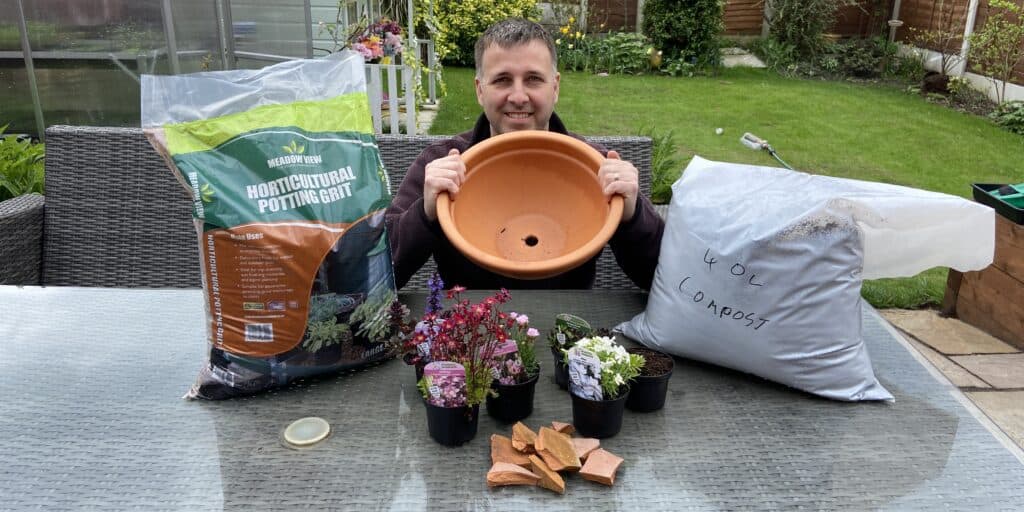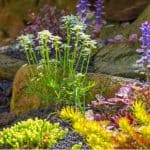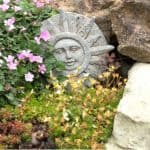Last updated on May 25th, 2022
Our site is reader supported, this means we may earn a small commission from Amazon and other affiliates when you buy through links on our site.
If you are looking to create and build an alpine rockery garden, it’s all about getting the right rocks and stones to offset the alpines to your advantage, and most importantly having well-drained soil. This can mean adding plenty of horticultural grit into the soil to improve drainage.
You can use a rock garden to give sun-loving plants access to the bright sun, with shade-tolerant plants nestled in a corner where the sun doesn’t reach as often. There is a lot of flexibility here. Moreover, with alpines, you have so many options. Originating from high altitude areas, higher than the tree line, these rock plants really embrace the cold. They won’t grow too tall, but you can gather a lot of them in one place and design a stunning rock garden.
What’s more, you don’t need a large space to do it. Smaller spaces are perfectly suitable because the key features are often dry stone walls or troughs, inside of which are containers of alpines. The alpines in question don’t get very big, most hovering around 10-15cm.
Check out our top 10 alpines for planting in a rockery garden here
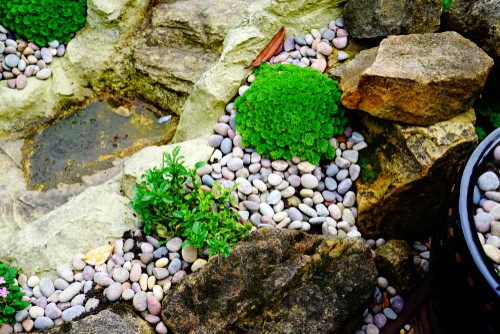
When to build your alpine rockery garden
A good time to construct the features is in the winter or autumn, especially because there is a lot less to do in your space otherwise, fewer plants in the way you need to be careful of, etc.
Spring is when you want to put the plants in and adding extra plants through summer will also work well. They ideally need time to establish themselves in their new space before the main part of the growing season begins, which is why planting in spring is perfect, plus garden centres and nurseries usually have the biggest selection of rockery plants in spring.
I have recently put together a step by step guide on how to create an alpine rockery planter here
Plan ahead when creating a rockery
It is important to plan ahead when you create and build the rockery so that you don’t have to go back and move heavy rocks or reposition pots. To that end, if you follow these steps you can make sure that does not happen.
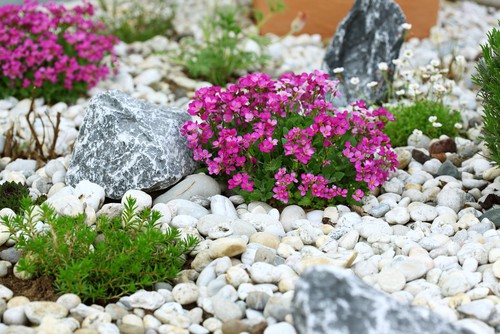
Step 1: Choose the Site
When you are ready, it’s time to choose a site. The site can be a small corner of your garden or your entire garden, depending on your microclimate.
Your goal should be to find an area that is most open, far from overhead trees or large tree roots, where your plants will get sun for the majority of the day. Remember, these are alpines that tolerate cold and wind, but they are still growing naturally above the treeline with direct access to the sun.
The more sun the better
It is important that you find a spot with access to the sun, even if only a few hours, over a spot with only shade all day.
Well-drained soil is a must
The position you choose should also be one with good drainage and this is probably the most important thing to consider. You can, of course, take the time to enhance your garden using raised beds but it’s simpler to focus on a naturally well-draining area or containers that are built into the area. One final point to consider is to always avoid a frost pocket if you can.
Step 2: Prepare the Site
Add drains if necessary and dig plenty of grit into the soil
Once you have found the site, it is time to prepare it based on the gradient, any necessary pipework underground, and how you plan to view it. You might want to consider taking some time to do a few sketches at this point, to really get a feel for what options you have. The important thing here is to insert drains to improve drainage if needed and add plenty of horticultural grit into the soil to further improve drainage. If you’re lucky you already have good-draining soil and simply digging in a little extra grit is all you need to do
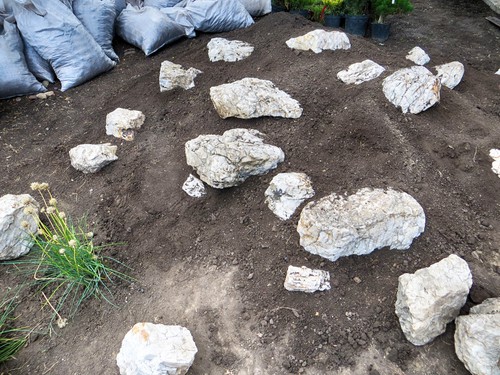
Step 3: Gather materials
Time to get your rockery stone pieces
Now is the time to get the materials. These are hard and heavy, and an investment. The materials you need are often rock, slate, or gravel. It is good to take a look around your local area to see what’s common, then find local stones if you can. Local stone goes a long way towards making your rockery look normal, blending in with the surroundings, and it will probably be easier to find. You can purchase salvaged stones or second-hand stones if possible. Garden centres and nurseries also usually sell rockery stones in different sizes and this is usually a good place to start.
Recommended stones:
- Sandstone is not too alkaline or hard and is widely available.
- Limestone is equally popular but they are more alkaline.
No products found.
Step 4: Construct the rockery
This construction phase might seem daunting, and it could prove useful to engage the assistance of a local landscaper to help, depending on the size and scope of your project. The instructions below assume you going all out and not just digging some grit into the soil and then laying rockery stone on top for planting. You can, of course, try this but you will have a more natural rockery if you follow the steps below:
- Start by marking out the area so you know where your rockery will be, a good way to do this is to get a bag of sand and pour it using a bottle.
- Remove any weeds by hand or use a weedkiller if necessary.
- Build your base out of stone, broken bricks, or other coarse rubble 15cm deep. This will form the base of the whole rockery that will later be covered with a layer of soil.
- Cover the rocks with a polythene sheet with holes every 10cm so that it doesn’t mix with your compost.
- Select bigger stones as your main stones and put them in place first.
- Then spread out the remaining stones around the keystones.
- Use a shovel or spade to make hollows in the ground into which the stones sit, for varying heights.
- Use things like small bricks and smaller stones to help add layers.
- Remember, the rockery should seem natural, not man-made, so you can do things like tilt the rocks backwards to achieve a good effect.
- Finally, add weed-free topsoil under and between the stones. The stones should be buried in place about one-third of their total size, deep. The best soil for this is a John Innes potting compost, however, this can be expensive so at a push, you can use normal topsoil.
- Around the stones, you want pockets of quality compost, where the plants will be planted.
Step 5: Planting rockery plants
Now it is time to put in the plants. These can be directly in the ground or in pots, put in the pockets around the stones. Note that if you plan to use containers, you need to leave pockets big enough to accommodate them.
The area for the plants needs to give them adequate drainage, access to sunlight and allow space for them to spread out as they grow.
If you are planting directly from another container, remove the plants carefully. Gently tease out the roots and remove any weeds. Then plant them firmly in your compost mix.
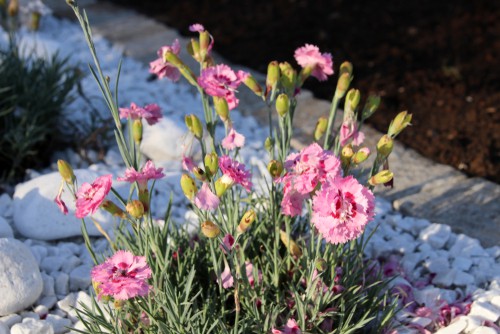
Recommended Alpines
Now that you have things set up, it’s time to find the right alpines. There are many from which to choose, but below are a handful of top options:
- Dianthus ‘Popstar’ – bright pink, toothed flowers, subtly scented.
- Lewisia longipetala ‘Little Plum’ – pink and apricot coloured, star-shaped flower clusters.
- Lithodora diffusa ‘Heavenly Blue’ – bright blue flowers on top of evergreen foliage.
- Phlox subulata ‘McDaniel’s Cushion’ – bright, magenta flowers that need a sunny spot.
- Saxifraga ‘Winifred Bevington’ – pink flowers on a red stem with evergreen foliage.
- Sedum spathulifolium purpureum – purple-tinged leaves with golden flowers.
- Sempervivum – many varieties available, with green foliage.
- Thymus ‘Silver Posie’ – a variety of Thyme that grows upwards and has variegated leaves.
- Veronica prostrata – a spreading plant, with blue flowers.
See our detailed article on 10 of the best rockery plants for making a rockery
Learn how to grow rockery plants from seed
Potential Problems
There are some potential problems you need to be aware of. These include:
- Ants: these can be problematic in the soil and are best treated with an ant killer if needed.
- Aphids: these can damage the plants (as with most plants) and these are best sprayed with a bug killer if they become a problem.
- Birds: these can pull the rosettes apart, providing nest boxes and bird food can help distract them from doing this.
- Slugs and snails: these can damage the soft growth, products like slug pellets will work well, however, we prefer to use more environmentally friendly controls such as slug catches that you fill with beer.
- Vine Weevils: these can damage roots.
Best selling rockery plants
- 20 Different Alpine Rockery Plants in 9cm POTS ~ Quality Alpines Direct from Specialist Grower in West Pinchbeck, Lincolnshire
- You will receive 20 DIFFERENT Alpine Plants in 9cm Pots - Carefully selected by us to provide a good mix of foliage and flowers from early Spring to Autumn.
- Photos show examples of previously despatched Alpine Collections at various times of the year. As growers, we supply spring, summer, autumn and winter. All sent with The Alpine and Grass Nursery's Plant Passport.
- Our family have been growing alpines for over 35 years, first in North Yorkshire and now in Lincolnshire. Beautiful rockery plants sent fresh to your door from us, the grower. Add a Greeting to the box for Free, Eg Happy Birthday Dad!
- Pot Size: 9cm.
- Supplied Height (Inc. Pot): 20–30cm.
- Characteristics: The selection of perennials have evergreen foliage and are extremely hardy plants.
- Flourishing Season: Colourful flowering through the Summer months, mid-May to mid-September.
- Water & Maintenance: The collection of plants require little water. Make sure to plant in retentive, well-drained soil in full sun. Drought tolerant over extended periods.
- HARDY ALPINE PERENNIALS - This Alpine mixed 6 pack features a carefully chosen selection of hardy perennials for UK gardens, including Leucanthemum, Phlox douglasii 'Eva', Campanula garganica 'Major', Armeria 'Abbey Deep Rose', Sagina subulata var. glabrata, and Helianthemum 'Ben Ledi'.
- LONG LASTING SEASONAL COLOUR - Enjoy a colourful display from Spring into Summer with a mix of unique flower shapes and tones, from bold reds and purples to soft whites and pinks. A varied blend that adds texture and visual interest to any garden.
- IDEAL FOR ROCKERIES AND BORDERS - These compact alpine plants thrive in UK conditions and are perfect for gravel gardens, alpine beds, containers, and borders. Drought tolerant and low maintenance, they offer reliable colour with little effort.
- GREAT FOR POLLINATORS AND GROUND COVER - This alpine mix attracts bees, butterflies, and other pollinators while providing low, spreading ground cover. An attractive, wildlife friendly choice for edging paths or filling gaps in borders and rockeries.
- CARBETH PLANTS - We are a Scottish based company with over 20 years experience in horticulture. With a large variety of plants for the garden, indoors and also gift wrapped for special occasions. We pride ourselves on prompt delivery as well as our quality and affordable plants.
- Attractive all year round
- Low maintenance easy to look after
- Great in borders or as a focal point in a Tub or planter
- 6 Different heathers shrubs
- Buy From Meredith Nurseries.
- 40 DIFFERENT Alpine Plants in 9cm Pots - Carefully selected alpine collection with The Alpine and Grass Nursery's Plant Passport.
- Photo shows example of previously despatched Alpine Collection - ALL GROWN BY US AT THE ALPINE AND GRASS NURSERY ~ HARDY ROCKERY PLANTS FROM WEST PINCHBECK IN THE LINCOLNSHIRE FENS.
- Our family have been growing alpines for over 35 years, first in North Yorkshire and now in Lincolnshire. Beautiful rockery plants sent fresh to your door from us, the grower.
- Add a Greeting to the box for Free, Eg Love you Grandma and Grandpa! xx
Image credits – Shutterstock.com
Last update on 2025-07-11 / Affiliate links / Images from Amazon Product Advertising API

